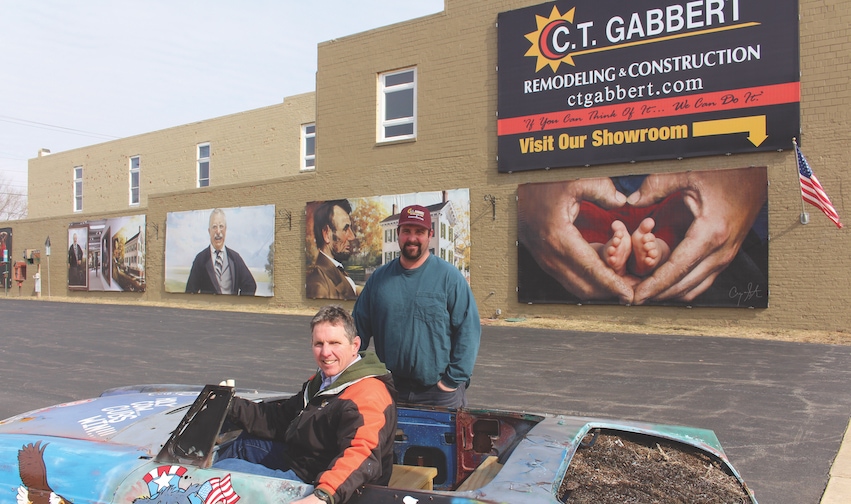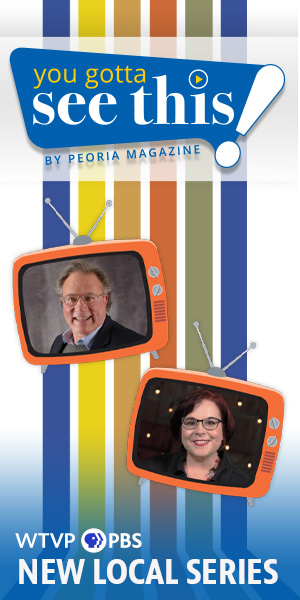Though it’s not always recognized, there is a longstanding relationship between the vibrancy of a community’s arts scene and its positive impact on businesses. In a recent article for The Michigan Daily, Alec Cohen writes: “Who do businesses want to influence? People. What influences people? Culture. And the arts, well, they play a ridiculously large part in culture.” Savvy business leaders understand that what makes an area attractive to prospective employees—and retaining current ones—is often inextricably tied to the vitality of its arts and cultural offerings. In short, the arts are a leading indicator of a community’s vibrancy and quality of life.
Beyond this, however, there is something even more meaningful driving local businesses to support the arts. It’s a recognition of the role the arts have played on a personal level, and the hope of leaving behind a legacy that transforms lives for generations to come.
Investment and Legacy
“When local business leaders and the community come together to support the arts, it creates a positive ripple effect that helps make our community the best it can be,” observes Janā Stevens, vice president of marketing at CEFCU. “CEFCU’s support for the arts is an investment in making central Illinois a wonderful place to live, work and visit.”
Founded in 1937, CEFCU (Citizen’s Equity First Credit Union) has a longstanding history of investing in the arts. “Peoria is fortunate to have very strong arts programs for any community—especially for one of its size—and CEFCU is proud to have supported many performances, events and exhibits through the years,” Stevens notes. “These events help increase engagement within our community, which has a positive impact for citizens of all ages and walks of life.”
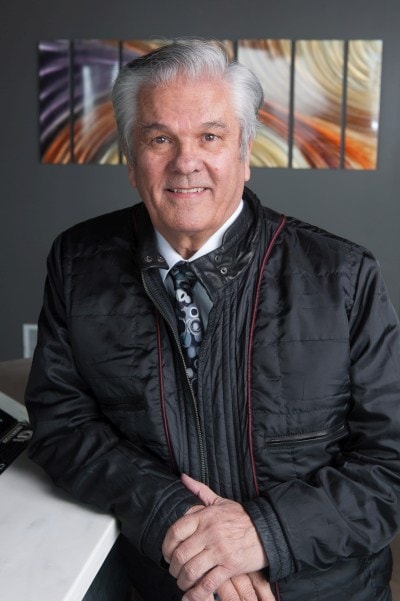
This holistic approach to business and community is a driving force at the core of Soderstrom Skin Institute’s support of the arts. “My grandfather came over from Sweden in about 1870—one of the very few things he brought with him was his violin,” explains Dr. Carl Soderstrom. “Since that time, every generation in our family has been musically-oriented.”
Since opening its first office in 1973, Soderstrom Skin Institute has grown into one of the nation’s most highly-regarded skin care facilities. And from music to the Peoria Riverfront Museum and more, it has become one of Peoria’s most ardent supporters of the arts.
Growing up, Dr. Soderstrom learned how to paint from his aunt and listened to recordings of John Philip Sousa marches with his father. In grade school, he vividly recalls the first time he heard Ferde Grofé’s Grand Canyon Suite, which left an indelible impression. “It is probably the most perfect musical piece that combines nature with music and beauty,” he declares.
This fascination with art, music, nature and beauty can be readily seen at his clinic locations and at “The Castle” on Grandview Drive. Built in 1928, the home was purchased by Dr. Soderstrom in 2012. Inside its walls, he hosts dozens of events every year, including a wide range of charitable fundraisers. Surrounded by carefully maintained gardens and full of original artwork, it is a gathering place unlike any other in the area. “I want to share it with the community,” Soderstrom says. “And the more people who enjoy it with me, I can enjoy it with them.”
Underscoring his various passions, Soderstrom notes that his legacy will be his family’s continued involvement in the arts. His son Steve studied music, drums and production at the world-renowned Berklee College of Music, while son Erik serves as artistic producer at the Ravinia Festival in Highland Park. Recently, his grandson Dylan Wolfgang (a nod to the composer Wolfgang Amadeus Mozart) joined him on stage at a Peoria Symphony Orchestra concert. “And the legacy of my great-grandfather bringing his violin over from Sweden carries on,” Soderstrom reflects.
Creativity Comes Full-Circle
That family connection—and the honoring of a legacy—is something with which Eric Hansen, vice president at Crawford, Murphy & Tilly (CMT), an engineering consulting firm, is intimately familiar. Hansen, a licensed engineer, grew up in the home of an artist: his father, James Hansen, taught art at Bradley University for more than 40 years. In the 1960s, James was part of the leadership team that created today’s Peoria Art Guild.
Nearly half a century later in 2016, CMT purchased the building which houses the Peoria Art Guild—bringing Hansen back full circle to his family’s involvement in the arts. CMT’s significant investment in renovating the building not only created a positive work environment for its employees; it secured the Guild’s presence in downtown Peoria. “It was a win-win-win situation for our business, the Peoria Art Guild and the City of Peoria,” Hansen explains.
Beneath CMT’s second-floor offices, artists display their work on the first floor and teach fine arts classes in the basement. Where some might see a divide between the worlds of engineering and the arts, Hansen sees a strong connection. “In a sense, engineers and artists are very similar,” he notes. “We create streets, buildings, parks and amenities that enhance our communities. Architecture, landscape architecture and engineering professions apply principles of science, technology, math and art to create communities.”
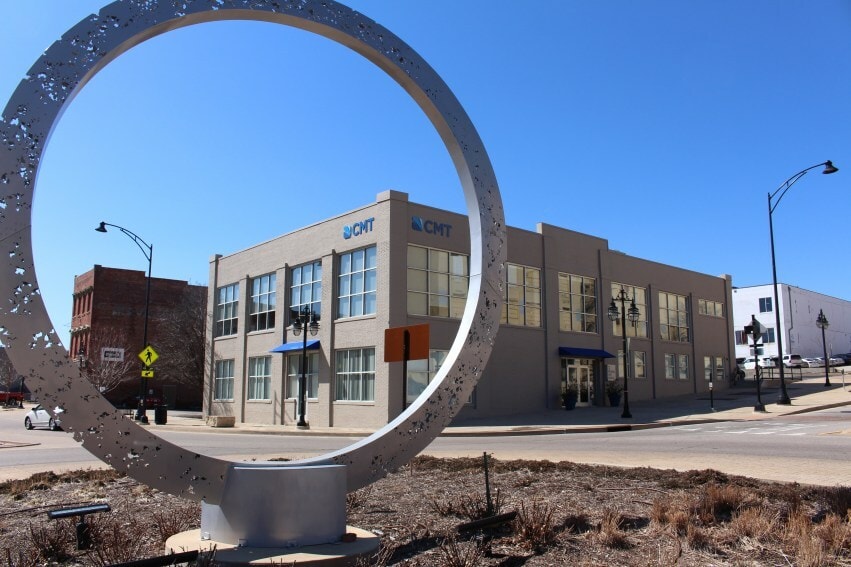
This recognition of the importance of art in all sectors—that the arts help people think critically and discover creative ways to solve problems—is at the core of many business leaders’ support. Like Hansen, Chuck Gabbert of C.T. Gabbert Remodeling & Construction believes that fostering creativity is essential to the success of his business. “We think of totally different ideas and ways of doing things,” he declares.
On the side of the C.T. Gabbert building at Adams Street and McArthur Highway hangs a series of murals which bring an explosion of color to a once-drab and monotone Warehouse District. Gabbert, who’s taken numerous art courses in his life, wanted to create a public art space for the community. “I had this idea about initially painting murals on the building… five of them on the side,” he recalls. Instead, he opted for vinyl murals, which allows them to be changed out periodically. “It’s really the coolest thing we’ve probably ever done.”
Complete with a small garden, a sculpture by local artist Matt Matheney, a “Little Free Library” housing books for the public, and a Milton MG sportscar that his son Joe paints regularly, the Gabbert Art Park has become a destination for local arts lovers and tourists alike—and a perfect backdrop for family photos. “When the Cubs won the World Series, Joe painted the car [in celebration]… and whole families were down there taking pictures for their Christmas cards,” Gabbert chuckles.
In 2017, Gabbert invited Dutch painter Ard Doko to do a live mural painting on the side of the building. Crowds formed throughout the day, their enthusiasm prompting an invitation for Doko to return—along with several other artists who were able to sell their work. Following the success of this small festival, Gabbert turned to local arts advocates Doug and Eileen Leunig. “I said, ‘This should be huge! We could do a big festival and have a big party,’” he recalls. “And that’s how the Big Picture Festival came about.”
Last October, the inaugural Big Picture Street and Film Festival brought together a dedicated team of artists, arts advocates and visionaries to celebrate public art, film and creativity in all its forms. Many of the activities took place in and around the Gabbert Art Park, where more than 30 chalk artists competed to win cash prizes. After a successful launch, Gabbert says he looks forward to seeing the festival grow in its second year. Until then, he and his son continue to rotate the murals on their building.
“We’re able to bring people together here,” Gabbert explains. “Nobody comes here and gripes about what’s going on or complains about the city… People come to our place just to have fun and enjoy it.”
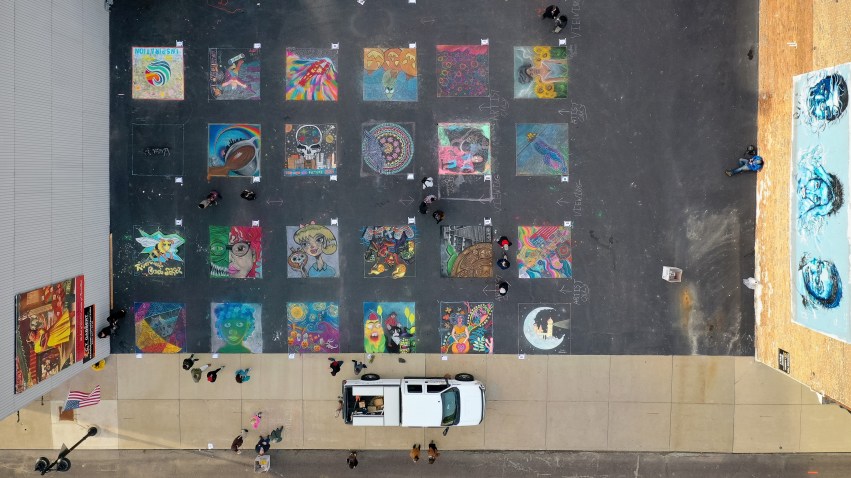
Building a Stronger Community
Many of the Peoria area’s strongest supporters of the arts were first introduced to art as children. Recognizing the importance of early childhood education, PNC’s “Grow Up Great” program is a philanthropic initiative focused on helping to prepare children from birth to age five for success in school and life.
“We feel that our biggest impact comes from supporting art interaction with children and their families. This could be funding a family-friendly exhibit at the Peoria Riverfront Museum, supporting the Peoria Playhouse Children’s Museum, or supporting education outreach at the Peoria Symphony Orchestra, just to name a few,” notes Jenna Cicciarelli Wiesner, PNC vice president and director of client and community relations. “The PNC Foundation has always believed that engagement in the arts enriches lives and builds stronger, more vibrant communities.”
The arts also play an essential role in fostering positive client relations. “At PNC we often host client events at our local museums or entertain clients at one of the Peoria Symphony Orchestra performances. In addition, the Peoria Civic Center brings so many wonderful shows to their theater and arena,” Wiesner says. “It is important for business leaders in Peoria to support the arts so we can continue to increase arts access and engagement across our community.”
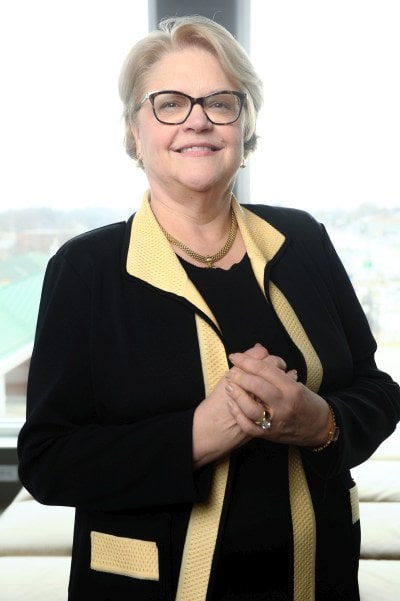
Cathy Butler, financial advisor at Morgan Stanley Wealth Management, agrees that it is essential for business leaders to step up as stewards of the arts in Greater Peoria. “Many of our arts organizations are over 100 years old, and we can’t afford to see those centers of our community vanish,” she observes. “It is imperative that we all support the arts to our greatest abilities. We can’t assume that someone else is taking care of them.”
As a child growing up in a rural area, Butler’s access to museums and musical performances was limited, but her teachers encouraged her to paint and take music lessons. “I still remember feeling alive as she taught us what we needed to know to get our feelings on paper,” Butler recalls. As she and her husband Stan raised their children, they took full advantage of all Peoria had to offer. “Music happens to be the glue that binds our family together,” she notes. “It is the universal language and is present wherever we have found ourselves in the world. It is the equalizer in the world and makes us all feel something.”
Like other business leaders, Butler has made supporting the arts a priority—not just because of what her family has gained, but for what it means to the wider community. “It gives our entire community a way to connect to each other,” she explains. “It doesn’t matter what our backgrounds are, when we find ourselves at the events and exhibits, we are all equal in our love and appreciation of our favorite art.”
For CMT’s Eric Hansen, business support for the arts just makes sense. “It is important to support artistic and cultural ventures in the same way it is also important to support scientific research and athletic activities,” he observes. “A healthy community offers many different activities and choices for how a person can earn a living and spend their leisure time.”
And with the war for employee talent raging, the breadth and diversity of a community’s offerings could very well be the critical factor in attracting and retaining young professionals—or losing them to the competition. PM


